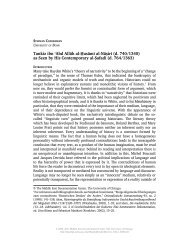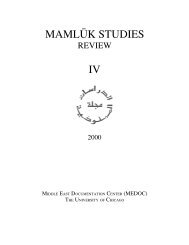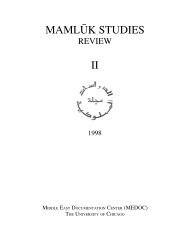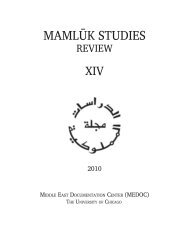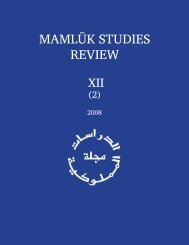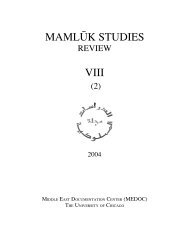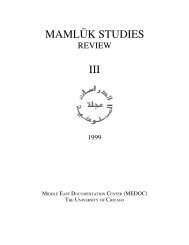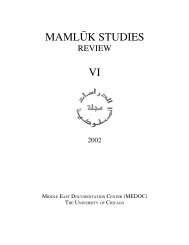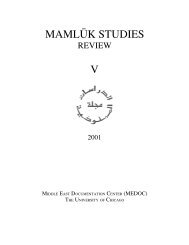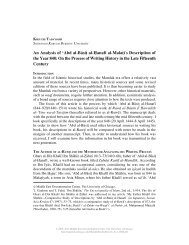Vol. VII, no. 1 (2003) - Mamluk Studies Review - University of Chicago
Vol. VII, no. 1 (2003) - Mamluk Studies Review - University of Chicago
Vol. VII, no. 1 (2003) - Mamluk Studies Review - University of Chicago
You also want an ePaper? Increase the reach of your titles
YUMPU automatically turns print PDFs into web optimized ePapers that Google loves.
MAMLU±K STUDIES REVIEW VOL. 7, <strong>2003</strong> 3<br />
Some amirs seem to have identified strongly with Arabic culture. Sanjar al-<br />
Dawa≠da≠r wrote poetry. Baybars al-Mans˝u≠r| wrote history. T˛aybugha≠ al-Ashraf|<br />
wrote a treatise on archery. The brutal amir Uzdamur al-Ka≠shif had memorized<br />
al-H˛ar|r|'s Maqama≠t, as well as much Arabic poetry. Quite a few amirs and<br />
mamluks interested themselves in Hanafi or Shafi‘i jurisprudence or in collecting<br />
and transmitting hadiths. However, although it is <strong>no</strong>t uncommon to come across<br />
references to sultans, amirs, and mamluks who spoke and wrote in Arabic, there<br />
seems to be more evidence <strong>of</strong> this level <strong>of</strong> culture in the fifteenth century than in<br />
earlier periods. 7<br />
The literary culture <strong>of</strong> the <strong>Mamluk</strong> period was Turkish as well as Arabic,<br />
though the production <strong>of</strong> literary works in Turkish mostly seems to have been a<br />
late development that reached its peak in the Circassian period. Turkish works<br />
composed within the frontiers <strong>of</strong> the <strong>Mamluk</strong> Sultanate were written in Kipchak,<br />
Oghuz, or a mixture <strong>of</strong> the two. It is one <strong>of</strong> the curious features <strong>of</strong> the Circassian<br />
period that, on the evidence <strong>of</strong> what has survived, more works were then translated<br />
from Arabic or Persian into Kipchak or one <strong>of</strong> the other Turkish dialects than in<br />
the preceding Kipchak Turkish <strong>Mamluk</strong> period. It seems probable that, despite the<br />
increased numbers <strong>of</strong> Circassians imported into Egypt and Syria in the later <strong>Mamluk</strong><br />
period, some form <strong>of</strong> Turkish remained the military lingua franca. It is difficult to<br />
consider the Turkish literature <strong>of</strong> <strong>Mamluk</strong> Egypt in isolation from that <strong>of</strong> the<br />
Golden Horde, Khwarizm, Anatolia, and Azerbaijan. The legacy <strong>of</strong> Khwarizmian<br />
Kipchak literary culture and its continuation in the lands <strong>of</strong> the Golden Horde was<br />
at first particularly important. Later on, translations into Oghuz Turkish, the dialect<br />
<strong>of</strong> the Anatolian and, more specifically, <strong>of</strong> the Ottoman Turks became more<br />
common. However, even towards the end <strong>of</strong> the <strong>Mamluk</strong> period, in the reign <strong>of</strong><br />
Qa≠nsű≠h al-Ghu≠r|, a mamluk called Asanba≠y min Su≠du≠n copied a Hanbali religious<br />
treatise by Abu≠ al-Layth in the Kipchak dialect for the royal library. Much <strong>of</strong><br />
what was translated into Turkish was instructional in nature, dealing with<br />
jurisprudence, hippology, or furu≠s|yah and hence <strong>of</strong> <strong>no</strong> interest to the student <strong>of</strong><br />
literature in the narrow sense.<br />
It seems that the earliest text on Turkish grammar to circulate in the Arab<br />
lands was produced by an Andalusian immigrant. Ath|r al-D|n Muh˝ammad Abu≠<br />
7 On the Arabic culture <strong>of</strong> the mamluks, see Ulrich Haarmann, "Arabic in Speech, Turkish in<br />
Lineage: <strong>Mamluk</strong>s and Their Sons in the Intellectual Life <strong>of</strong> Fourteenth-Century Egypt and Syria,"<br />
Journal <strong>of</strong> Semitic <strong>Studies</strong> 33 (1988): 81–114; Jonathan Berkey, "'Silver Threads Among the<br />
Coal': A Well-Educated <strong>Mamluk</strong> <strong>of</strong> the Ninth/Fifteenth Century," Studia Islamica 73 (1991):<br />
109–25; idem, "<strong>Mamluk</strong>s as Muslims: The Military Elite and the Construction <strong>of</strong> Islam in Medieval<br />
Egypt," in The <strong>Mamluk</strong>s in Egyptian Politics and Society, ed. Thomas Philipp and Ulrich Haarmann<br />
(Cambridge, 1998), 163–75; Robert Irwin, "The Privatization <strong>of</strong> 'Justice' Under the Circassian<br />
<strong>Mamluk</strong>s," Mamlu≠k <strong>Studies</strong> <strong>Review</strong> 6 (2002): 69–70.<br />
© <strong>2003</strong>, 2012 Middle East Documentation Center, The <strong>University</strong> <strong>of</strong> <strong>Chicago</strong>.<br />
http://mamluk.uchicago.edu/<strong>Mamluk</strong><strong>Studies</strong><strong>Review</strong>_<strong>VII</strong>-1_<strong>2003</strong>.pdf



